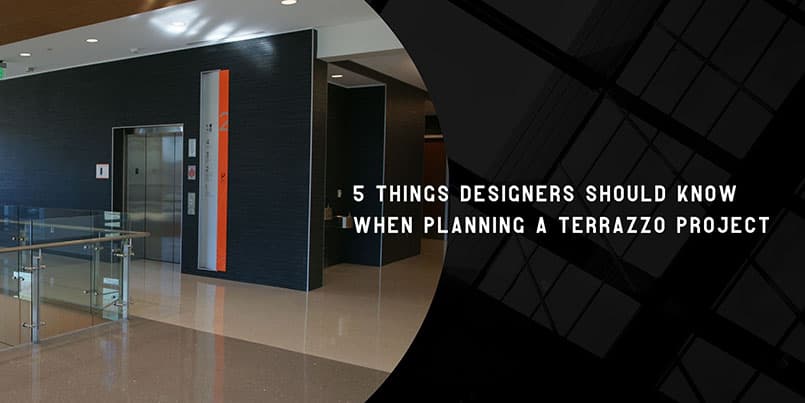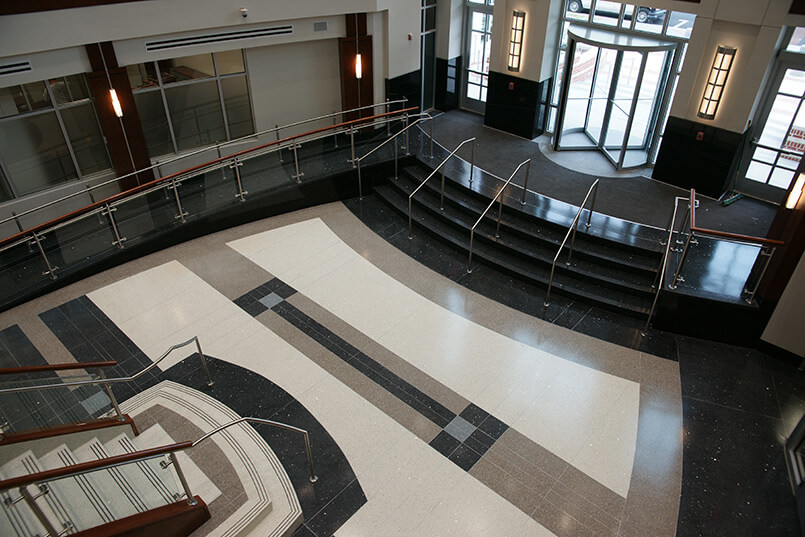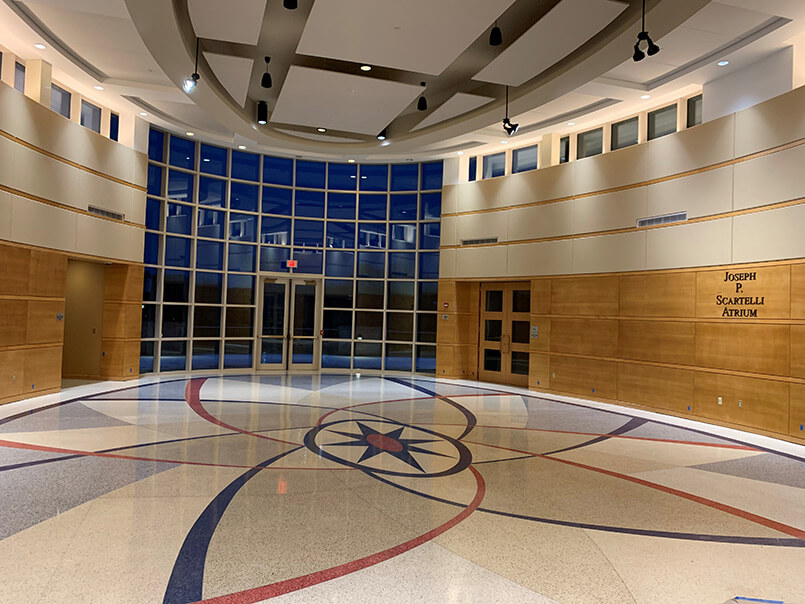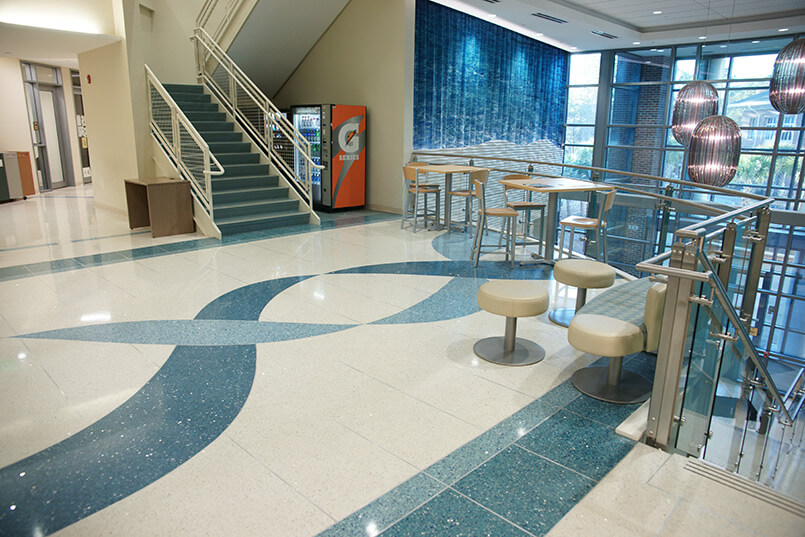12 Jul 5 Things Designers Should Know When Planning a Terrazzo Project

5 Things Designers Should Know When Planning a Terrazzo Project
In recent years, designers are embracing terrazzo floors for their performance and aesthetics. The option to customize the terrazzo floor’s appearance is appealing for designers today, as they are able to speak with clients and bring their ideas to life. Whether planning a terrazzo project for a hospital, a school, or a community center, it is well-known that terrazzo fits the needs of today’s commercial spaces.
And for many reasons. Terrazzo is durable, easy to maintain, and offers unique design capabilities uncommon with traditional flooring systems. If you are considering using terrazzo for an upcoming project, we’ve listed 5 things designers should know when planning a terrazzo project.
1.Communication and Collaboration is Key to Success
What are some goals you wish to accomplish for your building structure? For many designers, they want to work with partners they can trust. Terrazzo manufacturers can help designers build a better design by providing flexibility, communication, and product knowledge along the way.
Terrazzo floors often require more planning than other flooring materials. Since every terrazzo floor is unique in its appearance, designs must be approved before a terrazzo contractor can procure the materials for the floor. It’s a good idea to speak with a terrazzo company early on in the design stage. Terrazzo is a very collaborative process between the designer and the manufacturer, where solutions are recommended and mix designs begin to form. Communication between all parties ensures the project runs smoothly and delivers a quality outcome.

2. The Design of Terrazzo is Flexible
Designers should speak with the client to understand what they are looking for in a terrazzo design.
One of epoxy terrazzo’s best attributes is its design flexibility. This means that when planning a terrazzo project, designers have creative control to select various options including any matrix color, aggregates, polish level, and custom logos and graphics to include in the installation. The terrazzo floor can look exactly how the client wants.
In addition, designers can pair an epoxy terrazzo floor with terrazzo countertops, stairs, and wall base in matching or contrasting appearances.

3. Know Your Material Options and Systems
The more knowledge you have about terrazzo, the better-informed decision you will make for your project.
Terrazzo originates back to the early 16th century. Terrazzo systems before the 1970s were cement-based; however, with the introduction of epoxies, the industry has shifted to installing epoxy terrazzo. About 90% of terrazzo today is epoxy-based. It is much preferred by terrazzo contractors as it is quicker and easier to install. Designers also approve of epoxy terrazzo for its speed of install, artistic capabilities, zero VOCs and recycled materials.
So how will this impact your project? We’ll discuss some key topics that can guide your design decisions when planning out a terrazzo project.
Is your project indoors or outdoors?
One of the most commonly asked questions by designers is whether epoxy terrazzo can be used outdoors. The answer is no. Epoxy terrazzo faces challenges when exposed to ultraviolet rays and heat exposure from the sun. Therefore, a rustic (cement) terrazzo system is recommended only for outdoor applications. But when considering terrazzo for indoor settings, there’s no better system than a thin-set epoxy terrazzo system.
What type of aggregates do you plan to use in your terrazzo design?
While selecting a matrix color for terrazzo is easy, aggregates can require more planning. When reviewing aggregates, type, size, and hardness are things to consider. Aggregates types include marble, glass, shells, plastic, pebbles, and other decorative chips for epoxy terrazzo. It is important to pair aggregates that have similar hardness. For example, marble aggregates should not be mixed with a softer aggregate like plastic chips as the plastic chips will float to the top and marble chips will sink to the bottom during the terrazzo installation. Each aggregate will vary in price too; therefore, it’s important to discuss with the client their desired aesthetic and recommend suggestions by the terrazzo manufacturer.
What style of terrazzo floor are you looking to design?
And lastly, the size of the aggregate plays a role in the type of application used. As mentioned, with the industry shifting towards epoxy terrazzo installations, the size of the aggregate matters. Epoxy terrazzo is a thin yet durable flooring system that is installed at either 1/4″ or 3/8″ thickness. As a result, it is recommended to use aggregates graded at size 2 and smaller for poured-in-place applications. It’s possible to have go a bit large with Mother of Pearl and recycled glass chips because those chips tend to be flatter so they can fit into a 3/8″ thick system; however, it’s best to not include chips larger than the floor system itself. In recent times, modern terrazzo designs have displayed the use of Venetian chips, chip sizes #3 and above, which adds to the visual appeal of terrazzo.
Rule of thumb: As the aggregate size increases, so does the thickness of the terrazzo system as well as the cost.

4. Emphasize the Long-Term Value of Terrazzo
When compared to other flooring options, epoxy terrazzo provides the most value for commercial applications. However, one of the challenges for designers is discussing the upfront costs with clients. Designers and architects find value in terrazzo for its aesthetics, durability, and ease of maintenance.
What building owners may not know is that epoxy terrazzo is one of the cost-effective flooring systems available. If the plan is to build a structure designed for long-term use, epoxy terrazzo may be the ideal flooring option. The reason being is that terrazzo adds value for building owners by reducing overall maintenance costs. Terrazzo floors are built to last. When compared to materials like carpet and vinyl that require frequent repairs and replacements, terrazzo saves building owners time and money.
Furthermore, terrazzo manufacturers provide consultations for designers to discuss material costs. Depending on the project, designers and their clients may be surprised by how affordable terrazzo can be. If a building project has a tight budget, manufacturers can even suggest economical material options that can offer a long-lasting terrazzo floor design at the lowest initial cost possible.

5. Tile vs. Poured in Place
Epoxy terrazzo can come in two forms: tile and poured in place. Education is key to understand which system is right for you.
Poured in place involves an installation team creating the floor onsite. Epoxy resin and aggregates are mixed together and poured over a concrete slab and troweled at 1/4″ or 3/8″ thickness. Installers will then grind and polish the floor for a complete finish. In contrast, tile comes pre-finished at a manufacturer’s location and shipped to the job site for installation.
For large commercial projects, poured in place terrazzo outperforms tile products. Poured in place terrazzo creates a continuous bond to the concrete substrate, creating a seamless flooring system minus the grout lines commonly associated with terrazzo tiles. While there are 3/8″ epoxy terrazzo tiles on the market, designers have to account for the setting material which increases the overall thickness to 1/2″. The adhesive is placed on the back of the tile and laid across the concrete substrate. Terrazzo contractors like to give a fair warning to designers who select a tile product over poured in place terrazzo system for multiple reasons.
- Terrazzo tile cannot match the design capabilities of a poured-in-place terrazzo flooring system.
- There are greater risks that tile may crack or chip during the installation process, which could delay project timelines
- It may be more difficult to replace tile later in the flooring cycle, in circumstances where a product is discontinued.
However, with a poured-in-place epoxy terrazzo system, any terrazzo contractor can easily repair and patch the terrazzo floor if damages occur. They can easily find matching epoxy and aggregates, and perform the work at a small fraction of the initial installation costs.
Regarding lead times, it is easier for a terrazzo installer to obtain epoxy and aggregate materials to complete a seamless epoxy terrazzo floor. Poured in place terrazzo even gives installers full control to work their craft. On the other hand, there are only a limited number of precast terrazzo manufacturers in the country. Designers may benefit from finding a stocked item through third parties but will miss out on the customization of the terrazzo design. Precast terrazzo is a hot commodity today as architects are looking to add more versatility to their buildings with stairs, countertops, wall base, and other custom designs. As a result, depending on the manufacturer, lead times to produce a customized tile product could take several weeks to start production. For terrazzo flooring projects, a poured-in-place system is recommended to meet project delivery and bring the best value to commercial buildings.
When planning a terrazzo project, cost also plays a factor in whether tile or a poured-in-place system is chosen. Because poured-in-place epoxy terrazzo requires professional installation, it is believed that it costs more than tile installations. That is not always the case. Depending on the manufacturer and the area of the install, poured-in-place epoxy terrazzo is affordable for building projects. It’s recommended to speak with an installation company to know the actual costs.






